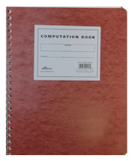LAB NOTEBOOKS
(These will be checked regularly and will form part of your grade)
You are required to have a lab notebook and to have your data written in it. Be neat and spread out. Allocate at least 20 pages per experiment. Write the following (in pen only) in your lab notebook:
- Your data, with narrative intro and diagrams.
- The procedures that you use to obtain the data, with discussion of calibration or systematics tests.
- The data analysis including the necessary theory and equations directly relevant to the analysis, plus plots.
For data acquired by a computer, you may past or staple the tables or plots of data into the notebook. The objective is to have all of the important information written down so that someone else could exactly reproduce the experiment and find the essential parameters simply be reading your lab book.
This information will be your primary source for both data and troubleshooting. For this reason it is important that you record as much as possible and erase nothing, use a pen. Too much information is better than too little as you never know where discoveries lay hidden. Here is one more reason why you might want to keep a notebook.
PREPARING A REPORT ON YOUR EXPERIMENT
Your laboratory report should be as professional as possible. Use the examples linked to the right. A colleague of yours, new to this course, should be able to understand your experiment and carry it out based on your report. Do not write a cook book ("do this, then that"). Rather outline the physics question, the experiment design, your procedure, analysis, results and conclusions. Write in non-bulletized, narrative style. Aim for about 15 pages 12 pt font, 12 pages 11 pt font. Your report should contain in essence the following sections in addition to a brief, descriptive title.
REPORT SCORE BREAKDOWN
-
(5 points) Abstract: After a 1-2 sentence statement of the scientific question, a brief summary of the experiment and the results obtained, including statistical and systematic error estimates.
-
(20 points) Introduction: States the motivation for doing the work and spells out the goal of the work to be performed. Also describes in some detail the theoretical background behind the experiment. Physics of the detector, optics, and electronics is completely described.
-
(20 points) Experimental setup and procedure: Clearly states why the methods used are adequate for the proposed goal of the experiment, sufficient for another student to understand what you have done. Tables of data runs, and a narrative describing tests for systematics.
-
(35 points, 15 points designated to error analysis) Results and Analysis: Displays the processed data that are essential to the goal of the experiment. States briefly how the original data are processed and analyzed before display. Most importantly, makes a comparison of the processed data with the theoretical expectations as outlined in the introduction. Be sure to include complete weighted chi-sq error analysis of the data and show error bars on graphs [if appropriate]. Don't display the unprocessed raw data--those should be in your lab notebook. All graphs need axes, tick marks, units and descriptive captions. See below for available software.
-
(15 points) Discussion: Answer the question: From the results obtained, have you achieved the goal set in the introduction? Explain. Do the results support the understanding of the subject within experimental uncertainties? Again, explain. Describe in depth the systematics. Suggest possible improved experiments which could result in greater precision.
-
(5 points) Conclusion. Restates the central scientific claim, with quoted errors. Very similar to abstract, but without background lead-in.
- Reference: Published journal articles, books, etc. relevant to this experiment, including experimental techniques, electronics, data analysis and statistics. Wikipedia is not an acceptable reference.
Style
Check out the study guide from MIT openCourseWare for additional information and an example of acceptable report style. Figures with fully descriptive captions must be inserted in the text [some could be in an appendix at the end.] Mimicking the Physical Review and Astrophysical Journal LaTex style is recommended and may result in a higher grade.
Curve Fitting
We recommend you learn Python. There are powerful statistical and plotting packages in Python, and it is open software. Two software packages are available on the computers in the Roessler lab: KaleidaGraph (simple analysis, curve fitting etc.) and Igor (sophisticated analysis and curve fitting with publication quality plots and graphics). In addition to the Python sites, online information regarding curve fitting can be found at the following:
KaleidaGraph Manual
KaleidaGraph Notes
KaleidaGraph Statistics and Fitting
KaleidaGraph Tutorial

